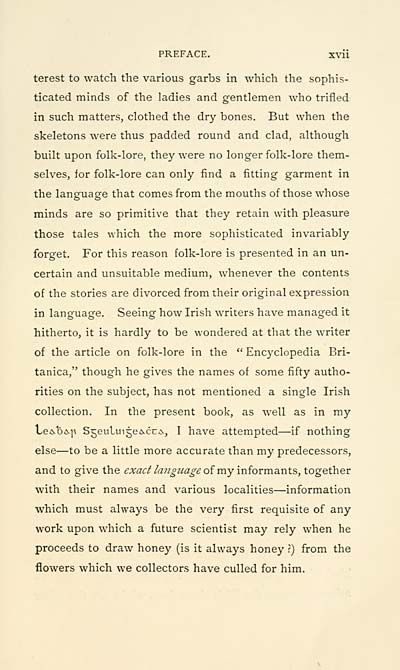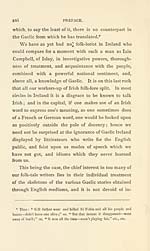Blair Collection > Beside the fire
(21)
Download files
Complete book:
Individual page:
Thumbnail gallery: Grid view | List view

PREFACE. XVIÍ
terest to watch the various garbs in which the sophis-
ticated minds of the ladies and gentlemen who trifled
in such matters, clothed the dry bones. But when the
skeletons were thus padded round and clad, although
built upon folk-lore, they were no longer folk-lore them-
selves, ior folk-lore can only find a fitting garment in
the language that comes from the mouths of those whose
minds are so primitive that they retain with pleasure
those tales which the more sophisticated invariably
forget. For this reason folk-lore is presented in an un-
certain and unsuitable medium, whenever the contents
of the stories are divorced from their original expression
in language. Seeing how Irish writers have managed it
hitherto, it is hardly to be wondered at that the writer
of the article on folk-lore in the *' Encyclopedia Bri-
tanica," though he gives the names of some fifty autho-
rities on the subject, has not mentioned a single Irish
collection. In the present book, as well as in my
"LeAb^p Sjeuluije^cc^, I have attempted — if nothing
else — to be a little more accurate than my predecessors,
and to give the exaci la?i£2iage oi my iniorma.nts, together
with their names and various localities — information
which must always be the very first requisite of any
work upon which a future scientist may rely when he
proceeds to draw honey (is it always honey r) from the
flowers which we collectors have culled for him.
terest to watch the various garbs in which the sophis-
ticated minds of the ladies and gentlemen who trifled
in such matters, clothed the dry bones. But when the
skeletons were thus padded round and clad, although
built upon folk-lore, they were no longer folk-lore them-
selves, ior folk-lore can only find a fitting garment in
the language that comes from the mouths of those whose
minds are so primitive that they retain with pleasure
those tales which the more sophisticated invariably
forget. For this reason folk-lore is presented in an un-
certain and unsuitable medium, whenever the contents
of the stories are divorced from their original expression
in language. Seeing how Irish writers have managed it
hitherto, it is hardly to be wondered at that the writer
of the article on folk-lore in the *' Encyclopedia Bri-
tanica," though he gives the names of some fifty autho-
rities on the subject, has not mentioned a single Irish
collection. In the present book, as well as in my
"LeAb^p Sjeuluije^cc^, I have attempted — if nothing
else — to be a little more accurate than my predecessors,
and to give the exaci la?i£2iage oi my iniorma.nts, together
with their names and various localities — information
which must always be the very first requisite of any
work upon which a future scientist may rely when he
proceeds to draw honey (is it always honey r) from the
flowers which we collectors have culled for him.
Set display mode to: Large image | Transcription
Images and transcriptions on this page, including medium image downloads, may be used under the Creative Commons Attribution 4.0 International Licence unless otherwise stated. ![]()
| Early Gaelic Book Collections > Blair Collection > Beside the fire > (21) |
|---|
| Permanent URL | https://digital.nls.uk/76243926 |
|---|
| Description | A collection of Irish Gaelic folk stories. |
|---|---|
| Shelfmark | Blair.222 |
| Additional NLS resources: | |
| Attribution and copyright: |
|
| Description | A selection of books from a collection of more than 500 titles, mostly on religious and literary topics. Also includes some material dealing with other Celtic languages and societies. Collection created towards the end of the 19th century by Lady Evelyn Stewart Murray. |
|---|
| Description | Selected items from five 'Special and Named Printed Collections'. Includes books in Gaelic and other Celtic languages, works about the Gaels, their languages, literature, culture and history. |
|---|

